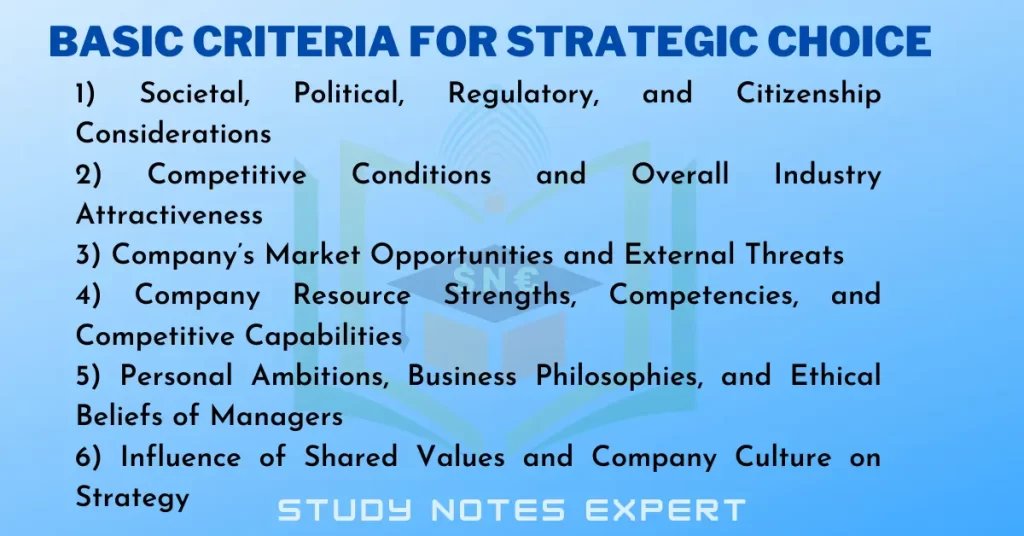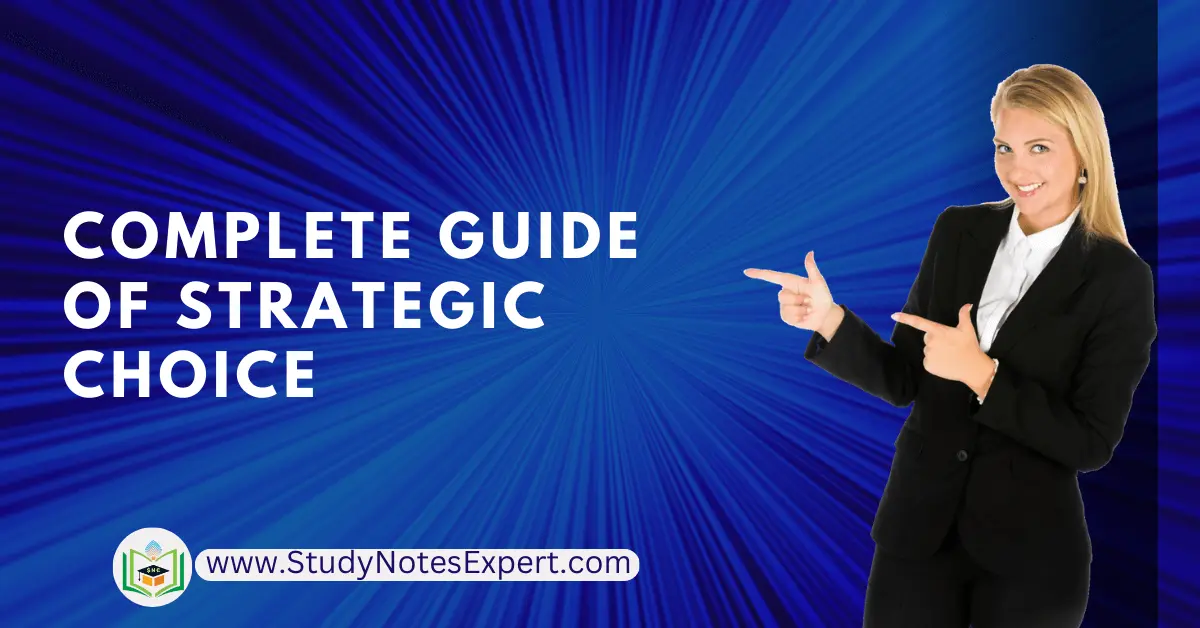The crux of effective strategic choice is to make good choices and to identify the key issues that affect the organization’s performance. For this, it also takes several steps to tackle the prevailing issues. Thus, the strategic choice process enables the organization to make appropriate and viable strategic decisions.
Meaning of Strategic Choice
Strategic choice is selecting the most suitable strategy that supports the organization in accomplishing its objectives. To make strategic choices, the strategists of an organization assess the strengths and weaknesses of the internal environment and the opportunities and threats of the external environment. After this assessment, several potential alternatives are found, and strategic choices are made from these alternatives.
Put, strategic choices identify the organization’s strategic direction, which it has to follow. A firm’s process to position its resources in the right direction is also a strategic choice. It involves various strategic decisions like what type of products and services to sell, where to sell them, how to sell them, and what target markets to sell them to. If a firm’s objective is to gain market share, the strategic choice will be to acquire a competitor. Another method the firm adopts can be to emphasize trade shows for selling its products and services instead of using advertising techniques.
Definitions of Strategic choice
According to Pearce and Robinson, “Strategic choice is a decision which determines the firm’s future strategy”.
According to Glueck and Jauch , “Strategic choice is the decision which selects from among the alternative grand strategies which will best meet the enterprise objectives. The choice involves considering selection factors, evaluating the alternatives against these criteria, and the actual choice”.
Professor Azhar Kazmi states , “The decision to select from among the grand strategies considered the strategy which will best meet the enterprise’s objective. The decision involves focusing on a few alternatives considering the selection factors, evaluating the alternatives against these criteria, and making the actual choice”.
A strategy should be such that it can achieve the best fit between the external threats and opportunities and an organization’s internal strengths and weaknesses. However, several subjective factors impact the final choice of strategy. Consequently, there may be a situation where various choice factors oppose other organizations. For that, the organization has to modify the strategy to choose the best possible strategy.
Basic Criteria for Strategic Choice

Several factors influence the choice of strategy in an organization. Some of these factors narrow the strategist’s range of alternatives and could act as restrictions. The significant factors are as follows:
1) Societal, Political, Regulatory, and Citizenship Considerations
Organizations have to operate within the defined boundaries of society and legislation. Their strategies and actions must not be against society’s welfare. The adoption of strategy of an organization is greatly influenced by government regulations, ethics, legality, responsible citizenship, and expectations of society.
2) Competitive Conditions and Overall Industry Attractiveness
An organization’s strategy also determines the competitive scenario and the attractiveness of the industry in which it operates. The organization’s strategy should customizes according to competitive aspects like price dynamics, quality, product performance, service, etc. In the phases of highly intense competition, the organization has to make suitable changes to its strategy and implement them to survive and maintain its place in the industry.
3) Company’s Market Opportunities and External Threats
Choosing a strategy also affects the opportunities in the market and the possible threats. The company’s strategic choice should adjust to take maximum advantage of available opportunities, enhance profitability, and gain a long-term competitive edge. It also counters the threats that can harm a company’s overall performance.
4) Company Resource Strengths, Competencies, and Competitive Capabilities
The current and potential resources, strengths, capabilities, and competencies an organization requires for successfully implementing a strategy are other internal factors affecting the strategic choice. These factors are the main basis of an organization’s strategy. Also, they can help make the most of an opportunity and attain a sustainable competitive advantage in the industry.
5) Personal Ambitions, Business Philosophies, and Ethical Beliefs of Managers
When choosing the correct strategic path, there is no half-hearted effort by the managers. They undertake strategic decisions based on their perception regarding the best way to compete, effective positioning, and the company’s desired image. A few factors which influence the managers’ strategic decisions have come up during detailed and casual observations. Some are values, ideologies, attitudes toward risk, personal ethics, and goals.
6) Influence of Shared Values and Company Culture on Strategy
The unique culture of an organization is an outcome of its policies, actions, beliefs, traditions, and philosophies. The organization’s strategic decisions are greatly in influence and controls from a robust culture. This strong influence is the presence of cultural values in the deep roots of management’s approach toward strategy formulation.
Subjective Factor of Strategic Choice
Several behavioral or subjective factors enter strategic choices. For example, according to Christensen et al., the managers responsible for firm destinies only look at what a firm might do or can do. In the apparent ignorance of the second of these factors, they appear strongly motivated by what they want to do individually. Therefore, these personal and subjective factors have reduced the importance of objective factors in strategic choices. The major subjective factors are:
- The key strategist’s value system.
- Personal preferences.
- Willingness to risks.
- The reaction to the competitor’s new organizational strategy.
- Internal political considerations.
These factors are as follows:
1) Personal Preferences of Key Strategists
The company that concerns is in effects from the key strategist’s personal preferences performs this type of strategies. The firm becomes a way to meet the promoter’s desires and aspirations, who typically play the role of critical decision-makers. Thus the organizational objectives and strategies, which will be chosen for attaining these objectives, represent these personal needs and ambitions.
2) Value System of Key Strategists
A personal philosophy framework that governs and influences the reactions and responses of an individual in any condition is the value system. Therefore, the key strategist’s value system affects the form of strategies the firm pursues. Terminal values and instrumental values are the two forms of values. The terminal values shape the firm’s strategy, while the instrumental values indicate how to implement these strategies.
3) Willingness of Key Strategists to Take Risk
There may be some risks in association with every type of strategy. Therefore, whether a risky strategy will selects directly affects through the willingness of key strategists to take the risk. As it may not be possible to get the best of all worlds, thus, the strategic choice is the trade-off between risk and opportunity, which is only sometimes based on logic. In the final analysis, the decision depends on the willingness to take a risk by the key strategists.
4) Internal Political Considerations
Strategy formulation becomes a political process in many organizations as many infernal political factors affect the strategic decision-making process. Political factors are not only restricted to political organizations, as these factors are mentioned as universal factors. Each organization is a combination of many people and their groups, and based on the internal power arrangement, each of their positions has some pulls and pushes. And the choice of strategy is affected by these pulls and pushes.
5) Competitor’s Reactions to New Strategy
The organization frequently employs the likely moves of key competitors to many strategic options in strategic choice. Organizations may pursue an aggressive counter strategy, especially if the competitors believe in aggressiveness. In many situations, the initiating firm goes for an aggressive strategy that directly influences the key competitors. Thus, the strategic choice of initiating an organization is affected to that extent.
Key Process of Strategic Choice

Choosing the correct strategy requires effective decision-making consisting of steps.
1) Focusing on Alternatives
In the first step, all the available alternatives are listed. The strategists study the deviation between the standard performance and the actual performance, called the gap analysis. This deviation or gap between the two becomes the basis for various strategic alternatives that the organization can consider. If the organization does not deploy an effective strategy in the initial stages, the gap between what is to be achieved and actual performance may increase, worsening the organizational position.
2) Evaluation of Strategic Alternatives
Once the alternatives are identified, the strategist analyses these based on their merits and demerits. This assessment is also based on several selection factors. Methods like corporate parenting, GE business screen, portfolio, etc., are useful.
3) Considering Selection Factors
The organization must consider “objective” and “subjective” factors while evaluating the alternatives. These factors are explained as follows:
i) Objective Factors
Objective factors result from detailed analysis, information, vital facts, and critical techniques. They can be of the following types:
a) Environmental factors
- Instability of environment
- Input supply from the environment
- Influential stakeholders
b) Organizational factors - The mission of the organization
- Strategic intent
- Business definition
- and weaknesses
ii) Subjective Factors
Subjective factors are judgmental and descriptive. The judgments can be either individual or collective. Some of these factors are:
- The strategies which have been employed earlier.
- The personal views of the decision-makers.
- Management’s perception of risk.
- Stakeholder’s influence.
4) Making the Strategic choice
The last step in the process is selecting the most feasible strategy. The strategist can select multiple strategies as well. In addition, a framework should be developed defining the strategy and the premise of its functioning. Creating and maintaining a structured and sequential process in selecting and implementing the appropriate strategy is the main objective of strategic choice-making.
Selection of Strategies
Making strategic choices facilitates an organized and intensive development process for formulating and implementing strategic decisions. Strategic choice and evaluation recommend the assessment of alternatives’ suitability under separate situations. Therefore, the last step is the selection of strategies. One or more strategies are needed for implementation. In addition, a blueprint defining the different techniques and the basic needs for their activities is required to be created. This blueprint is defined as the strategic plan. Moreover, it is also required to define some contingency strategies along with the chosen strategies.
Implementing a strategy is more challenging than that defining the strategy. Tough choices are often not taken at all, and sometimes choices that seem to have been taken fall apart before they are implemented. Barriers to the successful implementation of strategy can be recognized by developing alternative strategies regarding “where to play and how to win” with the help of making strategic choices.
The critical questions that inform the organization’s strategy development can be answered with the help of following thoughtful processes by the decision-makers. Participants commit to their choices of where and how they will concentrate on their efforts in the market and succeed by testing the possible scenarios against real-world data generated by groups.
Strategic Selection Criteria
According to David Aaker, strategic alternatives should be accepted to the degree that they are reactive to the external environment, involve sustainable competitive advantage, are organizationally feasible, consistent with other organizational activities, and provide adequate flexibility for the business and organization.

